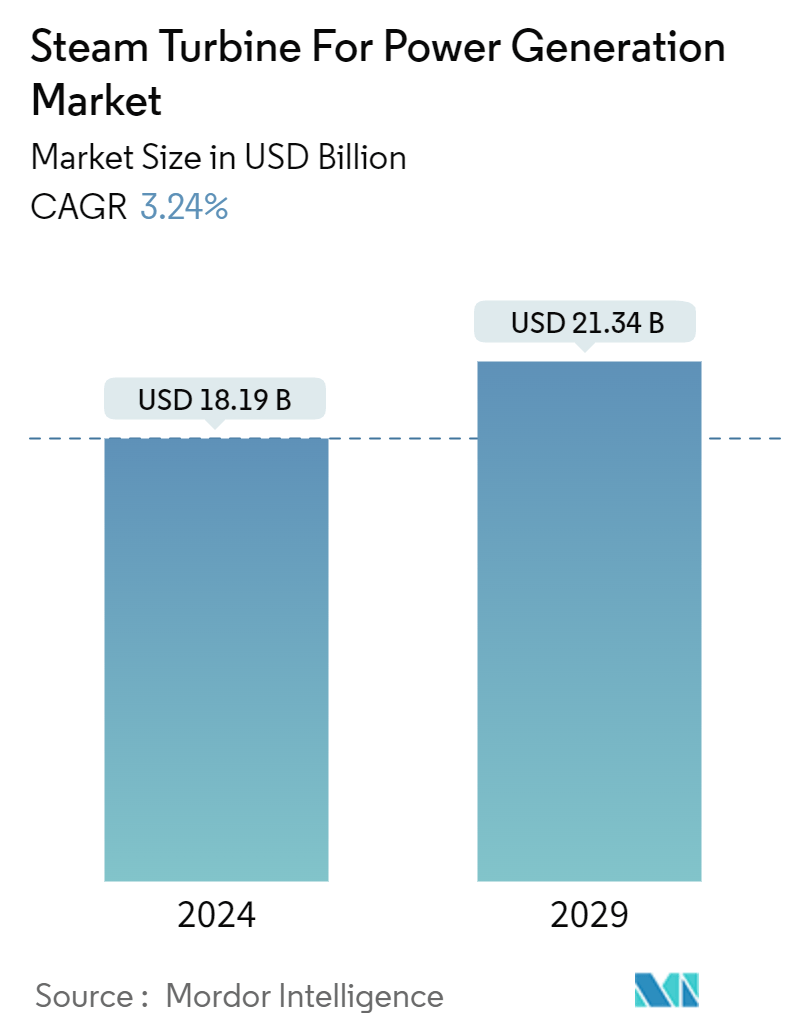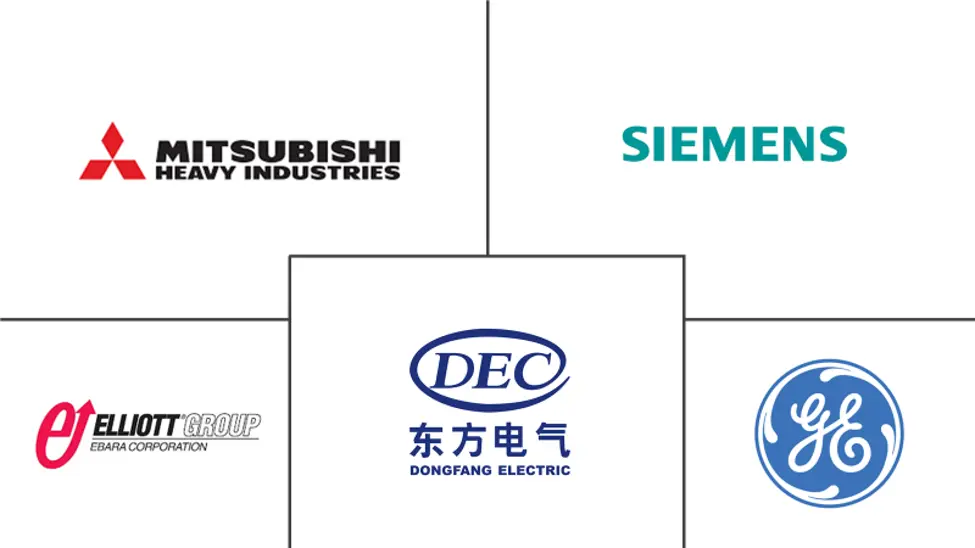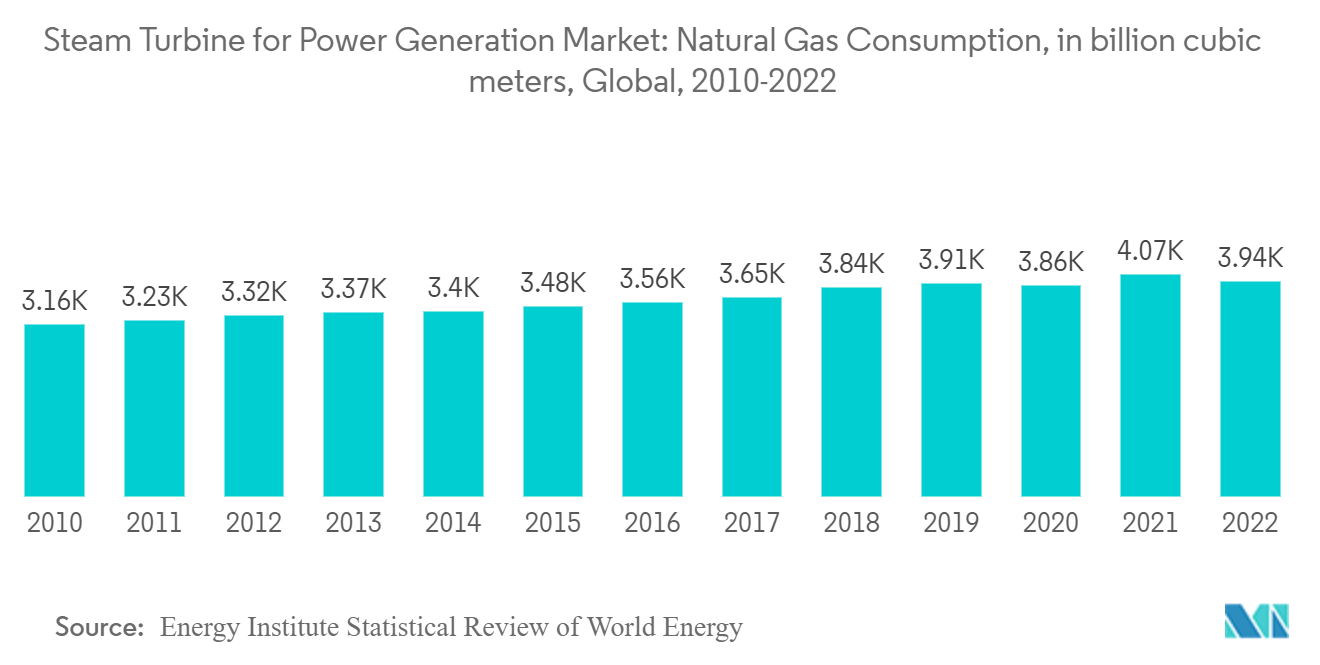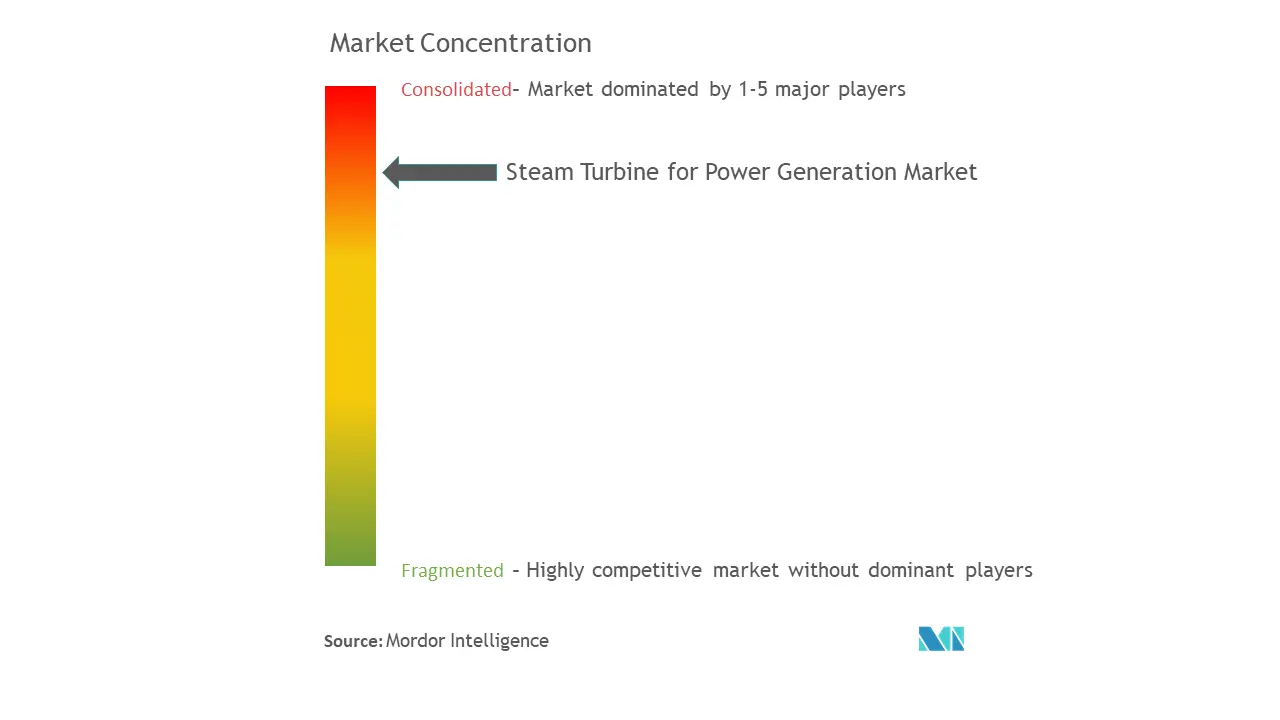Steam Turbine for Power Generation Market Size

| Study Period | 2020 - 2029 |
| Market Size (2024) | USD 18.19 Billion |
| Market Size (2029) | USD 21.34 Billion |
| CAGR (2024 - 2029) | 3.24 % |
| Fastest Growing Market | Asia-Pacific |
| Largest Market | Asia-Pacific |
Major Players
*Disclaimer: Major Players sorted in no particular order |
Steam Turbine for Power Generation Market Analysis
The Steam Turbine For Power Generation Market size is estimated at USD 18.19 billion in 2024, and is expected to reach USD 21.34 billion by 2029, growing at a CAGR of 3.24% during the forecast period (2024-2029).
- Over the medium term, factors such as upcoming natural gas combined cycle plants and thermal coal plants and growing emphasis on uninterrupted power supply are expected to drive the steam turbine for the power generation market.
- On the other hand, the increasing adoption of renewable energy power generation and the demand for clean energy sources are expected to hinder the market growth during the forecast period.
- However, increasing the efficiency of combined cycle power plants, with most of the demand coming from North America and Asia-Pacific, will likely create lucrative growth opportunities in the market during the forecast period.
- Asia-Pacific is expected to be the fastest-growing market during the forecast period due to the rising energy demand. This growth is attributed to increasing investments in the countries, including India, China, and Japan.
Steam Turbine for Power Generation Market Trends
The Gas Segment to Witness Significant Growth
- A gas combined-cycle power plant (CCP) uses gas. A steam turbine in this type of plant is expected to produce up to 50% more electricity from the same fuel than a traditional simple-cycle plant. The waste heat from the gas turbine is routed to the nearby steam turbine, which generates extra power.
- Compared to coal-fired power plants, natural gas combined cycle plants produce significantly lower emissions of greenhouse gases, such as carbon dioxide (CO2) and other pollutants like sulfur dioxide (SO2) and nitrogen oxides (NOx). This makes them a cleaner option for electricity generation, contributing to improved air quality and reduced environmental impact.
- The rising global demand for renewable energy has increased the popularity of natural gas power plants. The demand for gas is increasing, especially in Asia-Pacific, due to the shift from coal to natural gas. For instance, according to the Energy Institute Statistical Review of World Energy statistics, in 2022, the total natural gas consumption recorded about 3941.3 billion cubic meters around the globe. This is expected to create significant demand for natural gas as a power generation source.
- Natural gas combined cycle plants offer operational flexibility, allowing them to respond quickly to changes in electricity demand. They can ramp up or down their power output relatively quickly, making them well-suited for balancing the intermittent nature of renewable energy sources like solar and wind.
- With growing urbanization, rising demand for energy, and government efforts to boost industrialization and infrastructure development activities, the need for a global gas-combined power cycle is increasing. Many countries invest in these generation facilities to meet the increasing demand for electricity.
- Many natural gas combined cycle plants can be built or retrofitted at existing sites, leveraging the infrastructure for natural gas supply and electricity transmission. This can expedite the deployment of new power generation capacity.
- For instance, in March 2023, the Asian Development Bank announced that it would set up a 120 MW gas-fired combined cycle power plant in Tripura, India. Similarly, in the same month, the Government of Montenegro signed an MoU with companies like Enerflex Energy Systems and Wethington Energy Innovation from the United States on the construction of a liquefied natural gas (LNG) terminal and a gas-fired power plant. The CCGP plant will likely have a capacity between 240 MW and 440 MW.
- Therefore, natural gas combined cycle power plants offer a balance between efficiency, lower emissions, flexibility, reliability, and cost-effectiveness, making them a popular choice for electricity generation, thus increasing the demand for steam turbines around the globe.

Asia-Pacific Expected to Dominate the Market
- Asia-Pacific is already the largest market for steam turbines and is expected to create significant demand for steam turbines over the coming years. Thermal power generation in the Asia-Pacific contributes to more than 50% of electricity generation.
- China is one of the leading countries in Asia-Pacific, with the highest electricity generation capacity. With its large geographical area and to cater to a large population, the country needs to have increased electricity generation plants with continuous fuel supply for continuous power generation within the nation.
- As of January 2023, the country had the highest number of operating coal thermal power plants worldwide. Till January 2023, China had around 3,092 units of operating coal thermal power plants, 499 under-construction coal power plants, and 112 announced coal power plants. Hence, such a trend will propel the steam turbine market in the coming years.
- As per the Central Electricity Authority (CEA), the power-generating industry has grown. In FY2022-23 and FY 2023-24, thermal power plants rose by 2.77%, while renewable energy grew by around 11.11%. Thus, this signifies the increasing growth of renewable energy technologies to reduce reliance on fossil fuels for power generation.
- As per the Central Electricity Authority, nearly 31,040 MW of under-construction thermal power plants in India will be online in the next five years. Among all the under-construction, about 15,120 MW is likely to be operated by the central ministry, while 14,320 MW is expected to be operated by the state ministry. Hence, such upcoming thermal power plants will increase demand for steam turbines in the power generation market in the coming years.
- According to the Institute for Sustainable Energy Policies (ISEP), in 2022, fossil fuels constituted 72.4% of the overall electricity generation in Japan, marking a slight increase from the previous year's figure of 71.7%. The proportion of electricity generated from liquefied natural gas (LNG) decreased to 29.9%, down from 31.7% recorded in the previous year, partly influenced by price escalations.
- However, Japan's coal-based electricity generation saw an increase, rising to 27.8% compared to the previous year's 26.5%. Conversely, nuclear power contributed 4.8% to electricity generation, declining from the previous year's 5.9%.
- Thus, with the above developments and upcoming thermal power plants, Asia-Pacific is expected to dominate the market during the forecast period.

Steam Turbine for Power Generation Industry Overview
The steam turbine for the power generation market is semi-consolidated. Some of the major players in the market (in no particular order) include Siemens Energy AG, General Electric Company, Dongfang Turbine Company Limited, Bharat Heavy Electricals Limited, and Mitsubishi Heavy Industries Ltd.
Steam Turbine for Power Generation Market Leaders
-
General Electric Company
-
Dongfang Turbine Company Limited
-
Bharat Heavy Electricals Limited
-
Mitsubishi Heavy Industries Ltd.
-
Siemens Energy AG
*Disclaimer: Major Players sorted in no particular order

Steam Turbine for Power Generation Market News
- May 2024: GE Vernova completed the sale of a portion of its nuclear, conventional islands technology and services, including its Arabelle steam turbines, to EDF. Arabelle Solutions is a wholly-owned subsidiary of EDF. It is expected to supply equipment for new nuclear power plants and maintain and upgrade equipment in existing ones. Its steam turbines will be used in the EPR, EPR2, and SMR (small modular reactor) series.
- April 2024: Valmet announced it would deliver a steam turbine control system to Energie AG’s waste recycling plant in Wels, Austria. The company is migrating the current turbine controls to the Valmet DNA automation system to have a fully integrated control system for the whole plant. Valmet’s delivery for the 23.5 MW steam turbine includes redundant Valmet DNA turbine control, a new turbine protection system, and a new overspeed protection system.
Steam Turbine for Power Generation Market Report - Table of Contents
1. INTRODUCTION
- 1.1 Scope of the Study
- 1.2 Market Definition
- 1.3 Study Assumptions
2. RESEARCH METHODOLOGY
3. EXECUTIVE SUMMARY
4. MARKET OVERVIEW
- 4.1 Introduction
- 4.2 Market Size and Demand Forecast, till 2029
- 4.3 Recent Trends and Developments
- 4.4 Government Policies and Regulations
-
4.5 Market Dynamics
- 4.5.1 Drivers
- 4.5.1.1 Need for Continuous 24/7 Supply of Electricity
- 4.5.1.2 Increasing Penetration of Natural Gas for Power Generation
- 4.5.2 Restraint
- 4.5.2.1 Coal Fired Power Plants Carbon Emissions
- 4.5.2.2 Increasing Share of Renewables in Energy Mix
- 4.6 Supply Chain Analysis
-
4.7 Porter's Five Forces Analysis
- 4.7.1 Bargaining Power of Suppliers
- 4.7.2 Bargaining Power of Consumers
- 4.7.3 Threat of New Entrants
- 4.7.4 Threat of Substitute Products and Services
- 4.7.5 Intensity of Competitive Rivalry
5. MARKET SEGMENTATION
-
5.1 Plant Type
- 5.1.1 Gas
- 5.1.2 Coal
- 5.1.3 Other Plant Types (Nuclear, CHP, etc.)
-
5.2 Capacity
- 5.2.1 Below 40 MW
- 5.2.2 Above 40 MW
-
5.3 Geography (Regional Market Analysis {Market Size and Demand Forecast till 2028 (for regions only)})
- 5.3.1 North America
- 5.3.1.1 United States
- 5.3.1.2 Canada
- 5.3.1.3 Rest of North America
- 5.3.2 Asia-Pacific
- 5.3.2.1 China
- 5.3.2.2 India
- 5.3.2.3 Japan
- 5.3.2.4 South Korea
- 5.3.2.5 Malaysia
- 5.3.2.6 Thailand
- 5.3.2.7 Indonesia
- 5.3.2.8 Vietnam
- 5.3.2.9 Rest of Asia-Pacific
- 5.3.3 Europe
- 5.3.3.1 Germany
- 5.3.3.2 France
- 5.3.3.3 United Kingdom
- 5.3.3.4 Italy
- 5.3.3.5 Spain
- 5.3.3.6 NORDIC
- 5.3.3.7 Turkey
- 5.3.3.8 Russia
- 5.3.3.9 Rest of Europe
- 5.3.4 Middle East and Africa
- 5.3.4.1 Saudi Arabia
- 5.3.4.2 United Arab Emirates
- 5.3.4.3 South Africa
- 5.3.4.4 Qatar
- 5.3.4.5 Nigeria
- 5.3.4.6 Oman
- 5.3.4.7 Egypt
- 5.3.4.8 Algeria
- 5.3.4.9 Rest of Middle East and Africa
- 5.3.5 South America
- 5.3.5.1 Brazil
- 5.3.5.2 Argentina
- 5.3.5.3 Colombia
- 5.3.5.4 Rest of South America
6. COMPETITIVE LANDSCAPE
- 6.1 Mergers and Acquisitions, Joint Ventures, Collaborations, and Agreements
- 6.2 Strategies Adopted by Leading Players
-
6.3 Company Profiles
- 6.3.1 Siemens Energy AG
- 6.3.2 Mitsubishi Heavy Industries Limited
- 6.3.3 Bharat Heavy Electricals Limited
- 6.3.4 General Electric Company
- 6.3.5 Dongfang Turbine Company Limited
- 6.3.6 Toshiba Corporation
- 6.3.7 Doosan Enerbility Co. Ltd
- 6.3.8 Elliott Company
- 6.3.9 WEG SA
- 6.3.10 MAN Energy Solutions SE
- *List Not Exhaustive
- 6.4 List of Other Prominent Companies (Company Name, Headquarters, Revenue, Relevant Products and Services, Operating Sector, Recent Trends, Technology or Projects, Contact Details, etc.) (In Brief Tabular Format)
- 6.5 Market Ranking Analysis
7. MARKET OPPORTUNITIES AND FUTURE TRENDS
- 7.1 Increasing Efficiency of Combined Cycle Power Plants
Steam Turbine for Power Generation Industry Segmentation
A steam turbine is simply a metal-constructed rotor motor on an axle, which is one of the essential components of a combined cycle power plant and is used to generate electricity. A mix of compressed air with natural gas fuel is used to run the steam turbine, as well as in the HRSG (heat recovery steam generator). It is also an important component of the coal-based thermal turbine power plant, nuclear-based steam turbine power plant, and geothermal-based steam power plant.
The steam turbine for power generation market is segmented by plant type, capacity, and geography. By plant type, the market is segmented into gas, coal, and other plant types (nuclear, CHP, etc.). By capacity, the market is segmented into below 40 MW and above 40 MW. The report also covers the market sizes and forecasts across major regions. Market sizing and forecasts are made for each segment based on revenue (USD).
| Plant Type | Gas | |
| Coal | ||
| Other Plant Types (Nuclear, CHP, etc.) | ||
| Capacity | Below 40 MW | |
| Above 40 MW | ||
| Geography (Regional Market Analysis {Market Size and Demand Forecast till 2028 (for regions only)}) | North America | United States |
| Canada | ||
| Rest of North America | ||
| Geography (Regional Market Analysis {Market Size and Demand Forecast till 2028 (for regions only)}) | Asia-Pacific | China |
| India | ||
| Japan | ||
| South Korea | ||
| Malaysia | ||
| Thailand | ||
| Indonesia | ||
| Vietnam | ||
| Rest of Asia-Pacific | ||
| Geography (Regional Market Analysis {Market Size and Demand Forecast till 2028 (for regions only)}) | Europe | Germany |
| France | ||
| United Kingdom | ||
| Italy | ||
| Spain | ||
| NORDIC | ||
| Turkey | ||
| Russia | ||
| Rest of Europe | ||
| Geography (Regional Market Analysis {Market Size and Demand Forecast till 2028 (for regions only)}) | Middle East and Africa | Saudi Arabia |
| United Arab Emirates | ||
| South Africa | ||
| Qatar | ||
| Nigeria | ||
| Oman | ||
| Egypt | ||
| Algeria | ||
| Rest of Middle East and Africa | ||
| Geography (Regional Market Analysis {Market Size and Demand Forecast till 2028 (for regions only)}) | South America | Brazil |
| Argentina | ||
| Colombia | ||
| Rest of South America |
Steam Turbine for Power Generation Market Research FAQs
How big is the Steam Turbine For Power Generation Market?
The Steam Turbine For Power Generation Market size is expected to reach USD 18.19 billion in 2024 and grow at a CAGR of 3.24% to reach USD 21.34 billion by 2029.
What is the current Steam Turbine For Power Generation Market size?
In 2024, the Steam Turbine For Power Generation Market size is expected to reach USD 18.19 billion.
Who are the key players in Steam Turbine For Power Generation Market?
General Electric Company, Dongfang Turbine Company Limited, Bharat Heavy Electricals Limited, Mitsubishi Heavy Industries Ltd. and Siemens Energy AG are the major companies operating in the Steam Turbine For Power Generation Market.
Which is the fastest growing region in Steam Turbine For Power Generation Market?
Asia-Pacific is estimated to grow at the highest CAGR over the forecast period (2024-2029).
Which region has the biggest share in Steam Turbine For Power Generation Market?
In 2024, the Asia-Pacific accounts for the largest market share in Steam Turbine For Power Generation Market.
What years does this Steam Turbine For Power Generation Market cover, and what was the market size in 2023?
In 2023, the Steam Turbine For Power Generation Market size was estimated at USD 17.60 billion. The report covers the Steam Turbine For Power Generation Market historical market size for years: 2020, 2021, 2022 and 2023. The report also forecasts the Steam Turbine For Power Generation Market size for years: 2024, 2025, 2026, 2027, 2028 and 2029.
Steam Turbine for Power Generation Industry Report
The report provides a comprehensive market overview of the steam turbine for power generation industry. It covers market segmentation by plant type, including gas, coal, nuclear, and CHP, as well as by capacity, categorizing turbines below and above 40 MW. The industry trends indicate a significant market growth driven by advancements in technology and increasing demand for efficient power generation solutions.
Market data and industry statistics reveal that the steam turbine market is poised for substantial growth across various regions, including North America, Asia-Pacific, Europe, the Middle East and Africa, and South America. The market forecast suggests a positive market outlook with a steady increase in market value and market size.
Industry analysis highlights the key market leaders and their strategies to maintain a competitive edge. The market report also includes detailed industry information and research conducted by leading research companies, offering valuable insights into market trends and market growth.
The report pdf provides a detailed market review and market predictions, emphasizing the importance of industry sales and industry size in shaping the future of the steam turbine market. The industry outlook is optimistic, with market leaders focusing on innovation and sustainability to meet the growing demand for power generation.
The market research includes a thorough market analysis, identifying the key drivers and challenges faced by the industry. The report example illustrates the market segmentation and the impact of various factors on market value and market trends.
Overall, this report serves as a valuable resource for stakeholders, providing an in-depth market overview, market forecast, and industry outlook. It is essential for understanding the current market dynamics and making informed business decisions in the steam turbine for power generation industry.



